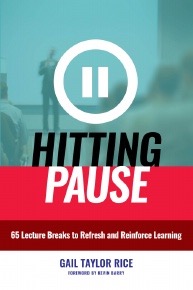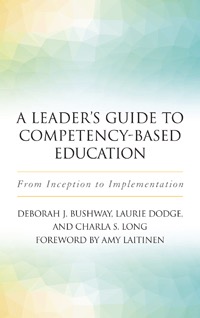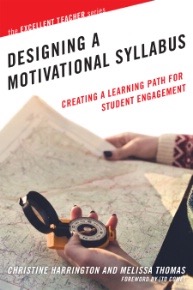course design
Select an item by clicking its checkbox

Hitting Pause: 65 Lecture Breaks to Refresh and Reinforce Learning
Date Reviewed: January 23, 2019
Timing is everything. It’s true for comedians and, according to Gail Taylor Rice, also for professors. Great comedians can hold an audience’s attention for over an hour because the attack-and-retreat nature of human attention. They know about volume control; high volume must be properly balanced with lower volume. Fast tempos must be tempered with slower tempos.
In the book Hitting Pause, Rice makes a compelling argument in favor of recognizing and designing classes in light of the rhythms of learning. Professors often suffer from the cognitive bias of "the curse of knowledge." This malady makes it nearly impossible for experts to put themselves in the shoes of someone who is learning things for the first time. A result of this curse is that it’s nearly impossible to appreciate how much time is needed for comprehending material.
Rice suggests that learners "might wish that there was a pause button connected to their college professors" (4). The pause button is a great metaphor. I think this idea could also be expanded as a highlighter pen for the lecturer. The professor needs to frequently slow down and make sure that students understand the importance of certain ideas.
The book rightly challenges the status quo of today’s university classroom as a place where professors read PowerPoint slides in darkened rooms while the gravitational pull of more interesting things like Instagram claim the student’s valuable and limited attention. Rice suggests that well-timed pausing can introduce the right kind of novelty and reflection to pull students out of their penchant for succumbing to time-wasting distractions.
Many educators believe the lecture is dead, and good professors will not use them. Lectures, however, aren’t necessarily bad; only bad lectures are bad. Rice offers solid research to give professors tested strategies for designing effective lectures that are punctuated with well-timed opportunities for reflection and emphasis.
According to Rice, starting a class with a pause invites students to become emotionally invested in learning. Again, we are so busy planning what we will teach that we forget to see things from a student’s perspective. An intentional pause forces us to think of starting a class like a pilot preparing for take-off. A good pilot will dutifully attend to a check-list to make sure that the plane is in good condition; teachers also need to consciously attend to their students’ current ability to learn.
The first half of Hitting Pause provides solid research about the pedagogical advantages of pausing. The second half contains numerous examples of starting pauses, mid-pauses, and closing pauses. Each example is categorized by appropriate setting and characteristics for use. The settings for use are divided into small classroom lecture, clinical or laboratory presentation, one-on-one session, conference presentations/in-service education, keynote/large-group presentation, course/unit, and online learning module. The characteristics include: affirming/positive, physical/movement, activates prior knowledge/experience, focuses/refocuses, creates community, generates curiosity, metacognitive, reviews, celebrates, commits to action, and provides a bookend. There are a great variety of examples which can be adapted to work in different settings.
Overall, this is a valuable book for teachers who are hoping to be more learning-centered.

A Leader's Guide to Competency-Based Education: From Inception to Implementation
Date Reviewed: January 18, 2019
Recognizing the growing interest in competency-based education (CBE) in U.S. higher education, but also the lack of shared standards or practices around it, three experts produced this guide for other educators who are contemplating a move to (or revision of) this type of instructional program. The authors help those who are enthusiastic about CBE avoid pitfalls by offering practical guidance. They strike a cautionary tone throughout, beginning their Introduction with the sobering reality that “there are relatively few schools that have been able to move from interest to implementation” (1).
One of the reasons for caution may be that even a definition of CBE is hard to come by. The authors joke that “if you were to ask ten people to define CBE, you would likely hear ten different answers” (2). Instead they offer five “hallmarks” of CBE: (1) “time is variable, and learning is fixed”; (2) there is “required demonstration of mastery or proficiency” which is (3) “determined by rigorous assessments”; CBE is (4) “focused on the student learning journey” and is (5) “offered in a flexible, self-paced approach” (3-4). Many educational programs would claim one or more of these hallmarks, but taken together, they represent a distinct departure from traditional education. CBE’s most famous feature may be the way it changes the relationship between learning and time by replacing the credit hour with continuous direct assessment. As the authors demonstrate, however, this change complicates everything from the transcript to faculty workload to accreditation. CBE’s intense focus on individualized student learning paths and assessment (“assessment on steroids,” as I once heard) is also significant because it changes what learners actually do to learn and what teachers do to teach. Traditional faculty roles are likely to be unbundled, “reassembled” (89), and redefined – or replaced – by roles like coach, tutor, and psychometrician.
Given the challenge of defining CBE and the guide’s relative brevity, it would benefit from some case studies, at least for readers who are still trying to gain a clear picture of what a CBE program looks like and why an institution might adopt one in the first place. Cases would presumably also help CBE adopters appreciate why other institutions made the choices they did. The book reads instead like an insider’s guide.
The book’s best feature, accordingly, is its soup-to-nuts review of issues that educators must consider when designing competency-based education. Chapters address institutional culture, program design, assessment strategies, staffing and business models, and approval seeking. Readers come away fully aware that CBE is not just a different teaching approach but a potentially radical disruption to education delivery.

Designing a Motivational Syllabus: Creating a Learning Path for Student Engagement
Date Reviewed: January 18, 2019
This book helps teachers think through the many functions and possibilities of the course syllabus, particularly as seen through the eyes of students. The authors advise thinking of the syllabus as a motivational tool rather than a punishing list of policies or a repository for contractual language; moreover, they suggest embedding more visual tools and images as well as more explicit rationales for assignments, even down to the individual class level. All of what they propose seems simple and reasonable, even for busy faculty. The authors clearly aim to help faculty see the excitement of creating “a course design tool that maps out the learning path for students” (19), and their suggestions will prove most useful to those beginning teaching who want to break out of the graduate school reading list mode and to those further on in careers, particularly those who might have changed (or want to change) their teaching strategies.
Harrington and Thomas write in an accessible and encouraging style throughout. After a brief consideration of the history and purpose of the syllabus in Chapter 1, they address the following issues in turn: applying course design principles with an emphasis on backward design; key components of any syllabus; policies and other boilerplate; issues of design; techniques for getting feedback and evaluating the syllabus; and ways of using the syllabus beyond its traditional roles. They helpfully include a sample syllabus as well as a syllabus checklist and sample grading rubrics. They lay out the main types of syllabi (coverage-based and activity-based) and argue for the superiority of a backward design that works from goals for students rather than from content or activities. They also champion Fink’s taxonomy of significant learning over Bloom’s, a distinction without a difference to readers who steer clear of learning taxonomies.
Many of the suggestions here seem more suited to a quick tutorial than a full-length book, particularly for seasoned faculty. But the biggest surprise is that this book scarcely addresses online learning management systems, an essential part of many courses that has, in some cases, completely replaced the single-document syllabus. Omitting this technology leaves a huge gap. This book would be greatly improved with a consideration of how the purpose and form of the syllabus has changed with the rise of learning management systems and how the principles described here apply to syllabus design in that context.
Harrington and Thomas rightly see the syllabus as a document that communicates expectations while explaining why the work of the course matters. Much of their focus is on tone and balance: even subtle changes in language and a careful curation of policies, such as those related to student behavior in class, can pay dividends in making students feel more positive and motivated to take on the work of the course. Although this book is not specific in any way to religious studies or theology, any teacher can benefit from a reminder of ways to improve this most standard of course materials.
Course design in online learning juggles a range of factors to produce an effective learning environment. For instance, most of us who teach online must navigate the expectations of our institution. Maybe a requirement to adhere to some external standard, like Quality Matters, exists. Perhaps the learning management system defines ...
Teaching and learning become rich and exciting when any classroom makes room for and taps into the resources of diverse backgrounds, contexts, and identities. Also, it’s the right thing to do. When I began teaching online, I knew classroom diversities might increase due to broadening access, but I suspected ...

